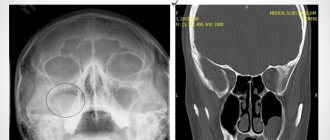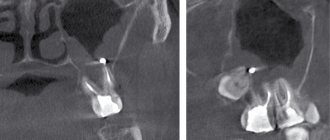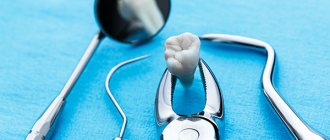Quite often in their practice, ENT doctors are faced with such a problem as paranasal sinus cyst. Despite the fact that the disease occurs frequently, in almost every tenth person, it is mainly discovered by chance, for example, during an X-ray examination for a completely different reason. This is explained by the fact that a cyst in the nose may not bother the patient for a long time and may not manifest any symptoms. Therefore, it is important to understand that timely treatment of cysts is necessary to avoid possible complications and to improve the patient’s quality of life.
What is a sinus cyst?
This is a large formation in which mucus or pus accumulates. The cyst is not dangerous, it does not degenerate into cancer, but over time it can grow and put pressure on the walls of the sinus. Because of this, breathing problems appear, the nasal mucosa swells, a runny nose almost never goes away, and recurrent bronchitis and pneumonia may occur. The cyst is sometimes located in such a way that there are no symptoms, and it is discovered by chance during another examination - for example, before dental prosthetics.
What causes cysts to form in the sinuses?
To ensure that the mucous membrane of the respiratory organs does not dry out, is not overcooled and is protected from dust, it contains glands that constantly secrete moisturizing mucus. This mucus flows to the surface through the ducts of the glands. If at least one of them is blocked, mucus continues to be produced, but will accumulate inside the gland, filling it and stretching the walls. As a result, a cyst appears.
The formation of cysts can occur due to:
- frequent infections;
- severe allergies;
- structural features of the nasopharynx;
- injuries and curvature of the nasal septum;
- inflammatory processes in the upper jaw (usually dental diseases).
The most common symptoms of a cyst are headaches, difficulty in nasal breathing due to swelling of the mucous membrane, discomfort or pain over the upper jaw.
Symptoms of perforation of the maxillary sinus floor
If the bottom of the maxillary sinus has been pierced as a result of treatment, the dentist should pay attention to the following symptoms:
- The appearance of air bubbles in the wound, the number of which increases as you exhale.
- Changing the timbre of the voice towards nasality.
- Bloody discharge may appear from the nose.
- The instrument the dentist was using falls into the perforation.
If we are talking about an old injury, then in this case chronic sinusitis develops due to an infection caused by a foreign body in the sinus. The main symptom of such sinusitis is pain in the sinuses and teeth. In addition, swelling appears, which can greatly interfere with nasal breathing. A purulent bloody secretion is discharged from the nose.
What to do if your teeth hurt and it’s hard to breathe with sinusitis? Contact your dentist as soon as possible. A sore tooth can very quickly lead to chronic sinusitis, a headache and a deterioration in overall health.
Symptoms of a sinus cyst
The cysts and polyps themselves are soft and lack sensitivity, so if they are small, many people may not notice them at all. However, multiple growths or a large cyst can block the nasal passages and sinuses.
Common signs and symptoms of nasal cysts include:
- runny nose
- reduced or absent sense of smell
- loss of sense of taste
- facial or headache
- pain in upper teeth
- feeling of pressure on the forehead and face
- snore
- frequent nosebleeds
Symptoms
Cysts of the maxillary sinuses are quite common (in every tenth patient), but are almost always discovered by chance during an examination for another reason, because in the early stages they do not bother us at all. The asymptomatic course of the disease is typical for small cysts, up to 1 cm in diameter.
With an increase in size, symptoms similar to those of sinusitis occur, which complicates differentiation from other ENT diseases:
- nasal congestion, difficulty breathing, especially after exercise
- yellow or green discharge even when there are no other signs of a cold
- decreased or complete loss of smell and/or sense of taste
- periodic pressing pain in the sinus area, radiating to the temple and eyes
- a specific crunch in the jaw when pressed or loaded
- incessant debilitating headaches
Indications for sinus cyst removal
It will not be possible to remove the cyst simply by relieving the inflammation; surgery is not necessary. Surgery is necessary if:
- pus accumulates inside the cyst;
- it is growing rapidly or its diameter is already more than 6 cm;
- pressure on the lower wall of the orbit increases (because of this, vision may deteriorate and double vision may appear);
- worried about frequent or constant runny nose and nasal congestion.
Important! Surgery to remove a sinus cyst is also recommended if the cyst is causing any discomfort. However, the size of the cyst in this case does not matter.
Solution
The cyst does not resolve on its own; it can only be removed through surgery to remove it. But the need for removal is not always present. If the formation is small in size and does not cause discomfort, a wait-and-see approach is chosen. The person is prescribed conservative treatment and undergoes periodic examinations to monitor growth dynamics.
Conservative treatment
It brings results only in the early stages, when the size of the cyst is up to 1 cm, the fibrous membrane is not too dense, there is no discharge or other clinical symptoms.
In case of infectious origin, combined drug treatment with anti-inflammatory, antibacterial and antiallergic drugs is prescribed. But the drug program does not guarantee getting rid of the pathology; it is more aimed at stopping the growth of the cyst. If small cysts are of odontogenic origin, endodontic root canal treatment is performed by a dentist-therapist, and a course of antibiotics is prescribed. As a result, the inflammatory process is eliminated, the cysts decrease in size and disappear over time. Surgical treatment
If the cyst is large in size, with a dense shell, there is purulent discharge, nasal congestion and pain as a result of pressure on the walls of the sinus are bothersome, the only treatment is surgical - removal surgery is performed. Access to the maxillary sinus is carried out according to one of the surgical protocols, which is determined by the doctor. In case of odontogenic origin of neoplasms larger than 1 cm, the causative tooth is removed along with the cyst, and the sinus is inspected. Then drug therapy is prescribed. Relapses are not observed with this method; the person gets rid of the problem once and for all.
Contraindications
The operations for removing sinus cysts are quite simple. Patients recover quickly after the intervention, and complications are rare. Contraindications are only general for any surgical interventions:
- acute infection;
- diabetes mellitus (severe);
- increased bleeding (blood does not clot well);
- pregnancy;
- epilepsy;
- oncology.
Before surgery to remove a cyst from the sinus, you need to take tests (for HIV, syphilis, hepatitis B and C, general blood test).
Diagnostics
Figure 1. Cyst in the maxillary sinus.
Source: Contemporary clinical dentistry / Open-i (Attribution-NonCommercial-ShareAlike 3.0 Unported) Before surgery to remove a sinus cyst, you need to take tests (for HIV, syphilis, hepatitis B and C, general blood test).
Usually, to make a diagnosis, the doctor only needs to collect an anamnesis and a general physical examination, including the nose.
Other diagnostic tests include:
Endoscopy of the nose. The doctor performs a detailed examination of the nose and sinuses using a narrow tube with a lighted magnifying lens or small camera.
Visualization methods. Images obtained from a computed tomography (CT) scan can help the doctor accurately determine the size and location of cysts in the deeper areas of the sinuses, and assess the degree of swelling and inflammation.
Test for cystic fibrosis. If a child needs diagnosis, the doctor may suggest testing for cystic fibrosis. This is an inherited disease that affects the glands that produce nasal mucus, tears, sweat, saliva and digestive juices. This is usually a non-invasive sweat test that can determine whether your sweat is more or less salty than most people.
What medical errors lead to perforation?
The presence of the problems described above does not guarantee that the tooth will independently enter the maxillary sinus. This usually occurs when there is a perforation - a break in the thin wall between the mouth and the nasal sinus. In the vast majority of cases, this occurs during dental procedures. And if monitoring the condition of teeth and preventing osteoporosis is the responsibility of the patient, then mechanical perforation is always the responsibility of the doctor. Of course, it is much more difficult for the latter to work if at least one of the factors described above is present. That is why good health (including teeth) is the result of cooperation between the doctor and the patient.
Patients often complain that the pain from sinusitis radiates to the teeth. A detailed examination reveals a radically opposite picture. Perforation of the bottom of the maxillary sinus is detected, which causes pain. The fact is that periodontitis may not make itself felt for a long time, but sinusitis debuts quickly. Therefore, it seems that the problem is in the nose, and not in the mouth.
Perforation in most cases appears as a result of a medical error made during the treatment or extraction of teeth.
Perforation of the maxillary sinus during tooth extraction
Removing a tooth if its root is located in the maxillary sinus or is separated from it by a thin layer of bone is always difficult. Especially when it comes to 2-3 molars with massive and intertwined roots. Since the dental surgeon applies physical force during the operation, there is a high probability of damaging the already thin layer of bone.
In this case, it is recommended to take a photo at the end of the procedure. Treatment of perforation of the maxillary sinus immediately after tooth extraction is simple. The doctor will be able to quickly restore the tightness of the sinus, avoiding complications. To exclude the possibility of a fistula forming in the nasal sinus after some more time, it is recommended to take a repeat photo after a month.
Perforation during implantation
A perforation of a sinus near a tooth during prosthetics is always a very serious complication that can cast doubt on the success of the entire operation. To prevent this, additional bone augmentation using various methods is performed before implantation.
Before implanting the implant, the doctor must take a panoramic photo. If the roots of a wisdom tooth or other molars and premolars are located in the maxillary sinus or in close proximity to it, then a sinus lift is prescribed, during which the bottom of the sinus is raised and strengthened.
If perforation does occur, then implantation is postponed until complete healing.
Perforation during endodontic treatment
Acute sinusitis can also develop after routine dental treatment. During canal treatment, it is easy to go beyond the apex with a metal instrument or filling material. To eliminate the possibility of complications and promptly eliminate perforation after each stage of endodontic treatment, it is important to take an image. Modern radiovisiographs have a very low radiation dose, so they cannot harm health in any way.
Perforation during removal of the apex or root of a tooth completely
From the point of view of perforation, tooth-saving operations can also pose a danger, for example, removing the root of a tooth with a cyst on it that has grown into the maxillary sinus. Such operations are relatively safe for teeth 4-5, while for teeth 6-7 they are no longer advisable. The risk of perforation is too great. It is worth clarifying that we are talking about cases with a pathologically thin bone septum between the nasal sinus and the oral cavity. If the bone thickness is within normal limits, then apectomy is performed for any tooth.
Types of operations to remove maxillary sinus cysts
The method of removing a cyst in the nose is chosen by the doctor. He takes into account its location and size. There are several types of operations.
Source: Symbolbild/Pixabay
Radical operation
This is a maxillary sinusotomy, in which an incision is made in the soft tissue (behind the upper lip) to gain access to the inside of the sinus in the oral cavity. They are peeled off, exposing the bone - the front wall of the sinus. Part of the bone fragment of the wall is removed to gain access to the sinus cavity. At the main stage, the surgeon cleans the sinus cavity from cysts, polyps and accumulated fluid, and rinses the sinus. The anastomosis with the nasal passage is widened, a drain is installed and taken out. The incision on the gum is sutured. The tampon is left in place for two days and then removed under anesthesia.
Figure 2. Stages of radical maxillary sinusotomy. Source: CC0 Public Domain
Important! Radical surgery is used relatively rarely, only if it is necessary to remove a large cyst or there are complications (separation of pus, inflammation, proliferation of polyps). Such an intervention allows you to completely scrape out and wash out the sinus, but it is dangerous due to complications (neuritis, the appearance of a fistula, bleeding). It is relatively difficult to tolerate and may require anesthesia and hospitalization.
Such an intervention allows you to completely clean and rinse the sinus, but is dangerous due to complications (neuritis, the appearance of a fistula, bleeding). It is relatively difficult to tolerate and requires hospitalization and anesthesia.
Endoscopic surgery
This is a minimally invasive procedure in which an endoscope is used to remove the cyst. The entire procedure takes about half an hour and is performed under local anesthesia.
To remove the cyst, an endoscope is inserted into the sinus through the nasal passage. Sometimes it is inserted through the tubercle on the upper jaw or the alveolar socket (through an additional channel with a diameter of 4–5 mm). The technique of access to the sinus depends on the location, shape and size of the cyst, as well as the individual characteristics of the patient’s nasopharynx. The path to the sinus through the nose is less traumatic and does not require an additional puncture. Access through the alveolar socket is used if the patient has had at least one molar removed (in adults, these are the sixth, seventh and eighth teeth on the left and right sides) on the upper jaw.
After entering the sinus under video control, the doctor pierces the cystic cavity and excises its walls, performs sanitation of the maxillary sinus, cleans it and rinses it with an antiseptic solution.
Endoscopic surgery has several advantages:
- there is no need to make an incision, the tissue is not injured;
- a video endoscope allows you to combine diagnostics with surgery (examine the sinus and immediately remove the tumor);
- The tissues of the mucous membrane are not damaged and scarring does not occur.
- Complications rarely occur;
- patients tolerate the intervention more easily and recover from it faster.
Therefore, the endoscopic technique is used more often than the radical one.
Figure 3. Endonasal removal of nasal cysts. Source: CC0 Public Domain
Important! Endoscopic removal is used for certain anatomical features of the structure of the nasopharynx, which can be diagnosed by a doctor. The technique is safe, almost does not injure the nasopharynx, and long-term rehabilitation is not required after its use.
Microsinusrotomy
In this case, a trocar (something like a surgical awl) and an endoscope are used. The procedure is also considered gentle. It is performed if the tumor can be removed through an opening in the anterior wall of the maxillary sinus.
At the first stage of the operation, access to the sinus is provided. To do this, a puncture with a diameter of 7 mm is made in the upper jaw. The puncture is performed with a trocar and an endoscope is inserted into the sinus cavity through it. Under video control, the cyst is punctured, its walls are excised, and the contents are removed.
In almost a third of cases, after maxillary sinusotomy, trigeminal neuropathy develops, which usually regresses without special treatment. Advantages: quick recovery, low swelling. Healthy tissues are almost not damaged.
Laser therapy
The laser is rarely used and only in combination with other surgical methods, provided that the cyst is small (otherwise it will take too long to remove it).
After surgery to remove a cyst, swelling of the mucous membrane, a feeling of dryness or profuse discharge from the nose, and pain in the area through which the sinus was accessed may appear. These symptoms are not complications of surgery and usually go away within a few days. If they persist and intensify, you should consult a doctor.
The nature of complications after surgery depends on the technique used:
- if access to the sinus was carried out through the alveolus of the tooth, an incision or puncture in the upper jaw, a fistula tract may form;
- with micromaxillary and radical maxillary sinus there is a risk of damage to the infraorbital or trigeminal nerve with the development of neuropathy. In this case, areas of the skin, nasal mucosa and mouth become numb, which may require treatment;
- inflammation and/or suppuration of the wound develops if it becomes infected (with poor quality oral care, in cases where the patient does not follow the doctor’s orders).
Treatment methods for sinus cysts
Treatment for cysts is not always surgical. Conservative methods are effective for small cysts. Surgery can be started only after acute inflammation has resolved. Therefore, the ENT doctor first prescribes conservative treatment. Whether surgery is necessary or not is decided solely by the attending ENT doctor. In some cases, a fairly long-term observation of the growth of the cyst and its “behavior” is required, which reveals all the nuances of formation in a particular person.
The patency of all anastomoses through which the sinuses communicate with the nose requires attention. Odontogenic cysts require the participation of a dentist; without him, treatment is not carried out.
Endonasal maxillary sinusotomy
- Cost: 40,000 - 75,000 rubles.
- Duration: 20-40 minutes
- Hospitalization: 1-2 days in hospital
More details
Surgical removal of paranasal sinus cysts is performed at CELT using the endoscopic method, which is the most gentle method. A small probe with a video camera and special instruments is used. The instrument is inserted into the nose - after anesthesia, of course. No incisions are made on the face or anywhere else. Thanks to a video camera, the surgeon sees everything that is happening on a large screen, where all the details are clearly visible. The cyst is first emptied, then its membrane, if any, is removed.
If the contents are purulent, additional rinsing with antibiotics is performed. The final stage of the operation is the formation of a full-fledged anastomosis between the sinus and nose, which prevents relapses. Of course, in the postoperative period, supervision by an ENT doctor is required.
It is also important to examine and treat children and adolescents. Often cysts first appear between the ages of 10 and 13 years, when they form on tooth germs that are displaced from their physiological place or impacted. Baby teeth can also become inflamed and give rise to the formation of a cyst. Treatment of children is carried out in a day surgical hospital for maximum comfort.
The CELT Clinic has accumulated a wealth of experience in the treatment of ENT pathologies, including cysts. By contacting otolaryngologists at CELT, you can be confident in a competent examination and treatment by experienced specialists.
Possible complications
After surgery to remove a cyst from the maxillary sinus, swelling of the mucous membrane, a feeling of dryness or profuse nasal discharge, and pain in the area through which the sinus was accessed may appear. These symptoms are not complications of surgery and usually resolve within a few days. If they persist and intensify, you should consult a doctor.
The nature of complications after surgery depends on the technique used:
- if access to the sinus was carried out through the alveolus of the tooth, an incision or puncture in the upper jaw, a fistulous tract may appear;
- with micromaxillary and radical maxillary sinus there is a risk of damage to the infraorbital or trigeminal nerve with the development of neuritis. In this case, areas of the skin, nasal mucosa and mouth become numb, which requires additional treatment;
- inflammation and/or suppuration of the wound develops if it becomes infected (with poor quality oral care, in cases where the patient does not follow the doctor’s orders).
Rehabilitation period
Figure 4. A cyst removed from the maxillary sinus with a tooth in it.
Source: Indian journal of ophthalmology / Open-i (Attribution 2.0 Generic) After surgery to remove a sinus cyst, no special recovery or treatment is usually required. Full recovery takes only a few days. With a small amount of intervention, patients feel well within a few hours after the intervention.
For the first time after surgery, it is advisable to avoid physical activity. You cannot visit the pool and sauna, you must not allow injuries. To avoid inflammation and other complications, you need to ensure high-quality oral hygiene and follow your doctor’s prescriptions.
Diagnosis of a cyst
A simple examination cannot detect a cyst. Based on a combination of complaints and other data, an ENT doctor may suspect that a person has a cyst in the paranasal sinuses. To clarify the diagnosis, instrumental diagnostics are needed, which allows one to identify the cyst.
The first step is an x-ray or computed tomography, which allows you to determine the relative position of the bones of the skull and nasal sinuses, their size and structure. Computed tomography provides a 3-dimensional image.
In unclear cases, especially during initial treatment, probing or puncture of the maxillary sinuses is performed. The goal is to obtain the contents and examine them in a laboratory setting. The punctate examines the presence of cells and their characteristics, the biochemical composition of the liquid, and the presence of bacteria.
After all the research has been carried out and the diagnosis has been clarified, treatment must be started.











